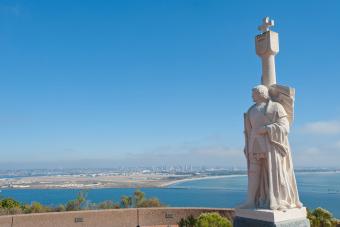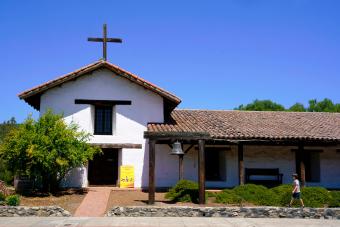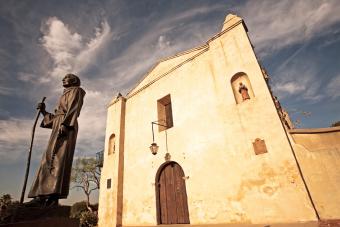
Known for their rich history and beautiful architecture, many Spanish monuments in California attract large crowds of visitors each year. The state and federal memorials were built to honor the Spanish legacy that helped shape early settlement in the California region of the United States. While these monuments aren't immune from scrutiny due to the colonial crimes with which they are synonymous, many of them are still standing and beloved today, and open to visitation year-round.
Californian Spanish Monuments and the History They Honor
The first Europeans to land on the American west coast were the Spanish, with Juan Rodriguez Cabrillo's explorative fleet in 1542. Subsequently, the Spanish continued to investigate the surrounding lands for centuries, until they established a permanent settlement in 1769 in San Diego entitled Presidio. By the early 19th century, California had transitioned into a Mexican province, which was later ceded to the United States in the Treaty of Guadalupe Hidalgo in 1850.
Despite entering the Union and adopting an American cultural identity over the course of two and a half centuries, the Spanish colonial imprint that was left on the Californian landscape still has a substantial presence. Thus, as the United States was wont to do in the past, many of the most significant sites relating to Spanish exploration in California were honored with monuments of varying styles over the course of the 20th and 21st centuries. Stretching the state's length, these monuments are cared for by several state and national organizations, and are considered popular tourist attractions today.
California's Cabrillo National Monument

Located in San Diego in California's Point Loma neighborhood, the Cabrillo National Monument was erected to pay homage to Juan Rodríguez Cabrillo, the Spanish leader of the first European expedition to explore what is now known as the west coast of the United States. He was a conquistador who served under the leadership of the now infamous Hernan Cortez; and although he first landed in Point Loma, Cabrillo and his men also journeyed further north, where they later landed in Monterey Bay and Point Reyes.
The Cabrillo National Monument was established in 1913 after being memorialized by U.S. President Woodrow Wilson to honor Cabrillo's expedition. The memorial is currently a part of California's National Park Service and includes tidepools, the Old Point Loma Lighthouse, walking trails, a statue of Cabrillo, a whale outlook, and a bookstore/visitor center. In spite of its colonial history, this protected space does serve as a delightful microcosm of both the environment and climate that have people flocking to California every year.
California's Spanish Missions

Although not considered a conventional series of monuments, the Spanish Missions (also known as the California Missions) comprise a series of religious outposts created by Spanish Catholics of the Franciscan Order. They were established between 1769 to 1823 to spread Catholicism to the native populations already thriving in the Californian landscape.
King Charles III of Spain implemented this idea to establish a series of religious missions. In his ethnocentric idealism, he wanted to create safe harbors for Spanish ships landing in the area and the colonizers who would soon follow, as well as prevent opposing European nations from securing settlements in the area first. After deciding that farming would work on the land, King Charles decided to turn the property into missions as not only a means of converting the non-Catholics, but also to provide labor for the farmlands. Each of these missions consisted of a building with a patio, church, graveyard, vast field for livestock and crops, and living quarters for the workers.
As they're currently preserved, these historic missions are rich in cultural memory. Some of these religious institutions feature rare frescoes, Moorish architecture, and so much more. Specifically, the 21 missions that were erected up and down the California coast are:
- San Francisco Solano
- San Rafael Arcángel
- San Francisco de Asís
- San José
- Santa Clara de Asís
- Santa Cruz
- San Juan Bautista
- San Carlos Borroméo de Carmelo
- Nuestra Señora de La Soledad
- San Antonio de Padua
- San Miguel Arcángel
- San Luis Obispo de Tolosa
- La Purísima Concepción
- Santa Inés
- Santa Bárbara
- San Buenaventura
- San Fernando Rey
- San Gabriel Arcángel
- San Juan Capistrano
- San Luis Rey de Francí
- San Diego de Alcalá
Additional Spanish Monuments to Visit in California

Smith Collection/Gado / Contributor / Archive Photos / Getty Editorial Use Getty Images License - Getty Editorial Use A statue known as The Hiker is one of more than fifty copies created to commemorate the American soldiers who fought in the Spanish-American War, Capitol Park, Sacramento, California, 1955 | Getty Editorial Use
While the Spanish missions and the Cabrillo National Monument are by far the most frequented Spanish monuments in California, there are other memorials and monuments all throughout the sizable state that you can visit. A few of these include:
- Spanish Landing Park - Built directly across the street from San Diego International Airport, Spanish Landing Park commemorates the Spaniards whose lives were lost journeying to North America in 1769.
- Los Cerritos Ranch House - While the Los Cerritos Ranch House is technically a type of 'house' museum, it's also a monument of sorts that commemorates the ranch's long history, starting with its birth in a Spanish land grant in 1774.
- The Spanish American War Memorial - Located in Sacramento, California, this non-settler monument was built in 1949 to honor all the veterans of the Spanish-American War.
- Alhambra Gateway Monument - Alongside a multi-year beautification campaign, the city of Grenada erected a Spanish monument, often referred to as the Alhambra Arch. This arch reflects the Moorish architecture of the nearby historic city, honoring the old town's Spanish heritage.
Spanish Monuments and Their Complex Modern Contexts

While these monuments are historic marvels in of themselves, they do represent a colonial campaign enacted by European settlers against the native populations already inhabiting the 'new world.' Thus, as many people living in the 21st century loudly seek inclusivity and restitution of these historically overlooked crimes, monuments like the Spanish ones in California are under a newfound level of scrutiny.
This criticism has led to some of these monuments being forcibly removed; the Junipero Serra monument, which was erected in 1965 at the state capitol to honor nine-time mission's founder Father Junipero Serra, was one of these casualties, and the statue is reportedly going to be replaced by a monument celebrating the native tribes of the Sacramento area.
Unlike what has previously been touted, nothing is set in stone. As the culture shifts, so too can the things that people see elevated in public spaces. So, keep in mind the contexts of these Spanish monuments when you're visiting them; and don't forget to hold space for the victims of the people that these monuments uplift as you stop to admire them.
Where the Past and Present Collide in California
When visiting California, there's truly more to do and see than is possible to imagine. Yet, as you make your way through the both lush and deserted countryside, you might want to take some time to visit one of the Spanish monuments nearest your location. At the very least, you can enjoy the monument's architecture and historic significance, and perhaps at the very most, you'll catch a glimpse of something for both the first and the very last time.







